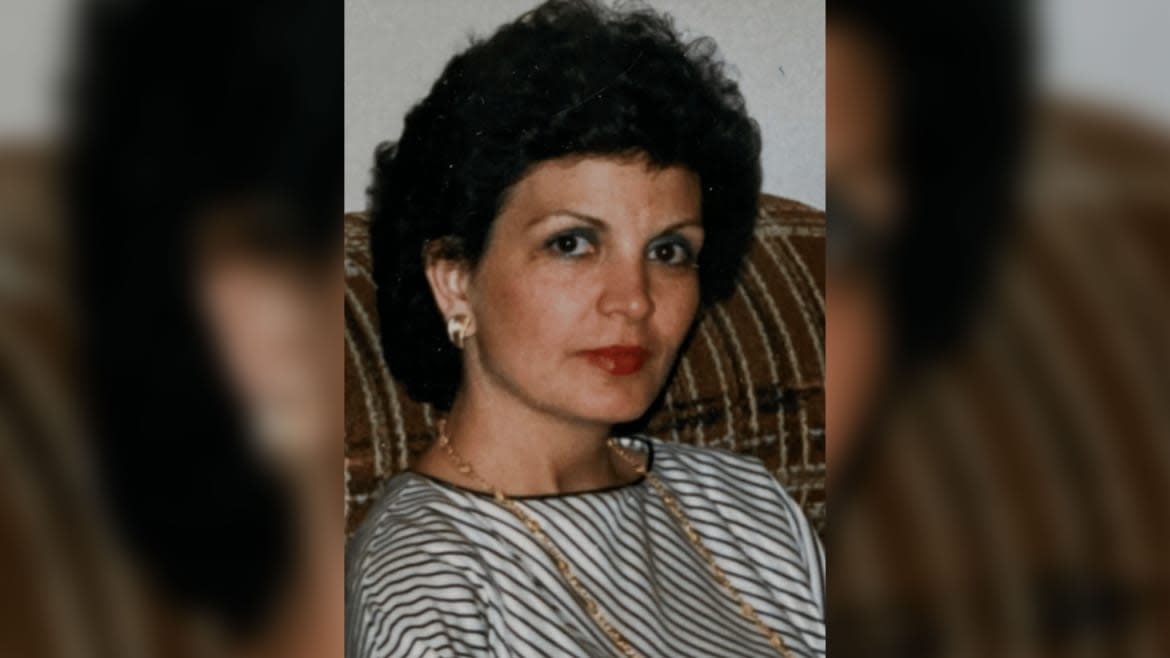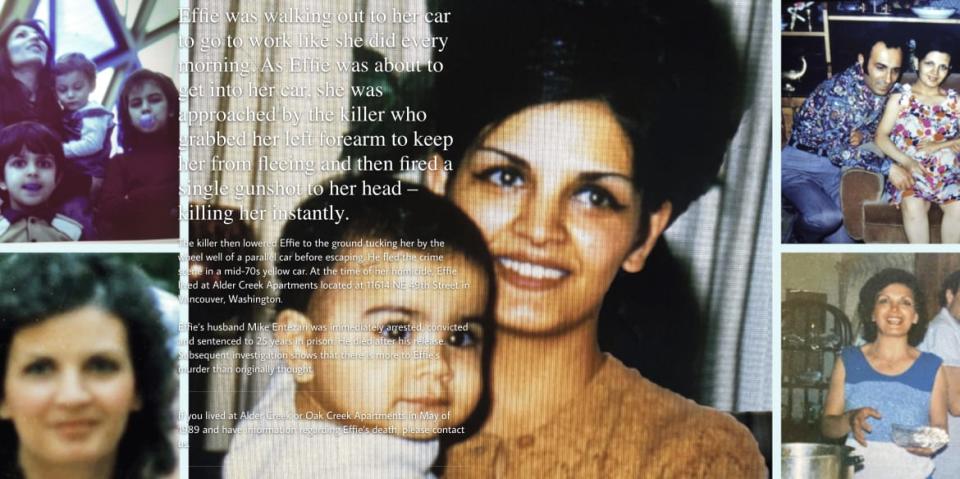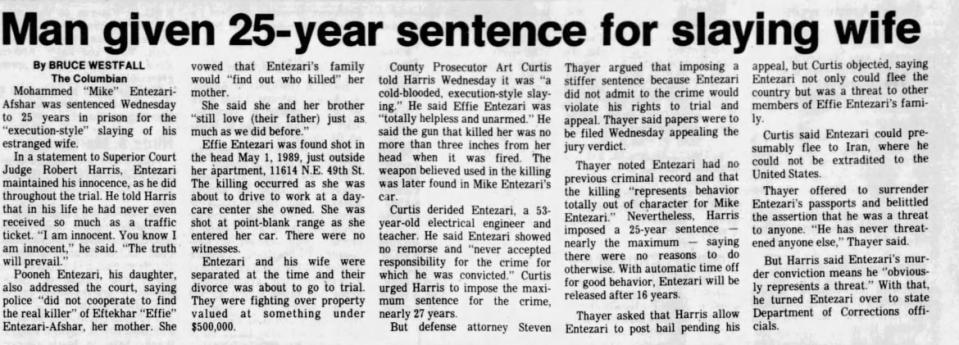Daughter Unearths Potentially Damning Evidence in Mom’s Murder After 34 Years

The horrific slaying of Effie Entezari in 1989 was as shocking as it was brutal—the mom-of-two was executed in broad daylight, shot in the head in her apartment building’s parking lot and left to bleed out on the asphalt.
Mohammad “Mike” Entezari, Effie’s estranged husband, was convicted of her murder just eight months later.
But the couple’s daughter, Pooneh Entezari Gray, almost immediately alleged that the case against Mike was shoddily assembled, using questionable evidence and experts. She’s since made it her life’s goal to clear her father’s name and to bring justice to her mom’s true killer—a daunting feat she believes she’s finally cleared, The Oregonian reported this week.
Gray, now 55, amended a previous lawsuit Monday to add the name of the man she believes killed her mother, an 85-year-old who still lives in her hometown of Vancouver, Washington, the newspaper reported.
It’s a massive breakthrough for Gray, who reportedly asserts in the lawsuit that she, along with the help of experts, was able to match DNA from the sweater her mom wore when she was killed to that of Viktor Pell—a fellow Iranian immigrant Gray believes was a hired hitman.
Pell, who does not have a criminal record in Washington or Oregon, could not be reached by The Daily Beast on Thursday. The Oregonian reported that its reporters recently knocked on his door with no answer.
Gray told The Oregonian she believes her mom’s murder was ordered due to her knowledge of a criminal operation run by people she’d recently befriended. It’s unclear who those people are and what criminal activities they may have been conducting.
“New evidence shows that Effie was killed to keep her from exposing an Iranian international criminal conspiracy—and that Mike was framed for her murder,” the suit states, according to The Oregonian.
Gray previously told the paper she suspects her mother likely found out what her new friends were up to, which included stealing from her—knowledge that she believes led them to organize her execution while framing Mike to take the fall.

The “About Us” page of a website dedicated to Effie Entezari.
Gray has long attested that cops had tunnel vision for her father, an engineering instructor at a local university—despite him having an alibi, a gun free of blood splatter and not having a trace of his DNA turn up at the scene.
DNA technology in the late 20th century was still in its infancy, however, and cops in Clark County initially refused to hand over its evidence to Gray for her to investigate herself. As the decades passed, however, Gray was able to convince new leadership to hand over key evidence for her to probe—so long as she footed the bill.
Her private investigation impressed local authorities, with the county’s deputy prosecutor, Aaron Bartlett, telling The Oregonian in 2020 that he was “impressed with the work Pooneh has done.” He added that she’s “tenacious,” and her work forced prosecutors to re-visit the probe into her mom’s slaying, but they’ve so far stopped short of launching a new criminal probe entirely.
That’s why Gray decided to file a lawsuit and named Pell as the suspected killer, reportedly hoping that it will force local authorities to launch a new criminal investigation. Gray’s lawsuit reportedly insists that it does not make the accusations lightly, while laying out what she claims is incriminating evidence against Pell and exculpatory evidence for her father.
“What Defendant Pell did not know in 1989 was that he left significant amounts of DNA on the left arm of Effie’s sweater,” the lawsuit said.
Past reporting by The Oregonian said the DNA from Effie’s sweater had a likelihood ratio—a way to determine how likely it is that DNA belongs to someone—of at least 10,000. It’s an amount that University of Oregon biology professor Bill Cresko told The Oregonian would “convince” him to call their suspect a match to the DNA.
Rod Englert, a forensic scientist and former deputy hired by Gray, told The Oregonian the DNA match is so damning that cops will have to act. Others hired by Gray, many of whom have worked in law enforcement in the Portland area, have said the same.
“We have a suspect we believe—and believe we can prove—is the killer,” Renee Rothauge, Gray’s lawyer, reportedly said in a February court hearing for the lawsuit, before Pell was publicly accused by Gray of being a suspect in the case.
News reports from 1990 said Mike’s conviction centered heavily around a spent bullet that was recovered at the scene. The defense, who called two forensics and gun experts, said the bullet was too damaged to determine what type of gun the bullet that killed Effie came from.

A headline announcing the sentencing for Mohammad “Mike” Entezari in 1990.
The defense also insisted that Mike’s handgun was clean of any blood splatter or proof it’d recently been cleaned when it was recovered. Given the suspected distance between Effie’s head and the gun, the defense said it would have had, at the least, specks of blood splatter on it.
The prosecution countered with testimony from Larry Hebert, the Washington state crime laboratory’s chief firearms examiner. He agreed that his examination of the gun for “blood, tissue or other significant trace evidence” turned up nothing, but asserted that it was “not unusual” for that to happen since other factors “can have somewhat of a shielding effect” to keep the blood away.
This meant, according to Herbert, that Mike could have fired his handgun within a foot of his wife’s head and it remain totally clean. He added that the spent bullet, which the others claimed was too damaged to determine what type of gun it came from, fit perfectly with Mike’s weapon.
“I would have to say I can pick out perhaps 20 to 30 individual [characteristics] that I would feel correspond very nicely,” he testified, later adding that he was “certain” the bullet came from Mike’s gun.
Herbert’s testimony was key to the prosecution’s victory. Mike was sentenced to 25 years behind bars, despite pleas from him, his son and Gray insisting that he wasn’t the person responsible.
“I am innocent,” he told the judge at sentencing. “You know I am innocent. The truth will prevail.”
Mike, had an appeal denied in 1993, served 16 years in prison before he was released in 2006 for good behavior, dying of natural causes a few years later.

Newspaper clipping from 1993, when Mohammad “Mike” Entezari had his appeal denied in his murder case.
Englert told The Oregonian that he spoke to Mike after his release and recalled he was a “broken man,” but his intelligence still shined through. It was then that he reportedly realized that Mike was too bright to kill his wife in broad daylight and hold onto the gun for hours, even after crossing multiple bridges prior to his arrest.
“I can’t believe he’d be stupid enough to do it like that, in broad daylight, in plain view,” Englert told The Oregonian. “This was a hit. Happens all the time.”
Gray’s lawsuit has poured cold water on Hebert’s claims about the spent bullet, with independent ballistics experts saying new 3-D imaging has proven the bullet couldn’t have come from Mike’s weapon.
Rocky Edwards, a U.S. Army-trained forensic firearms examiner that analyzed the bullet, told The Oregonian that it had a massive groove through it, likely because it was fired from a gun with a damaged barrel. Mike’s gun, however, had no damage to it—he’d purchased it recently after a string of weird events had him on edge, including weird messages left for him that were framed as if they came from Effie.
“My conclusion is [Mike’s] gun was not used in the homicide,” Edwards said.
That conclusion backed up other details gathered the day of the killing. A hand print left on a car near where Effie was shot didn’t belong to him, and hand swabs and nail scrapings that were taken the night of the shooting did not indicate Mike had fired a weapon recently. None of his DNA was recovered from the scene.
Gray said she believes her father was framed for the murder—a massive coverup that wrecked her family and its reputation.
“Now they know my dad couldn’t have killed my mom with that gun,” Gray told The Oregonian. “They need to do the right thing. It was devastating what happened to my family. It’s time there’s justice for my mother and my father.”
Get the Daily Beast's biggest scoops and scandals delivered right to your inbox. Sign up now.
Stay informed and gain unlimited access to the Daily Beast's unmatched reporting. Subscribe now.

